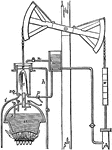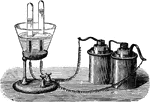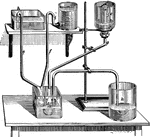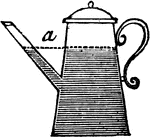
Water Pressure
"Therefore, the small quantity in the spout balances the large quantity in the pot, or presses with…
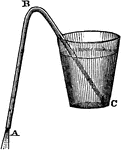
Syphon
"Take a tube bent like the letter U, and, having filled it with water, place a finger on each end, and…
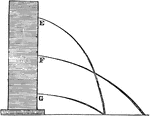
Water Velocity and Gravity
"If a vessel be filled with water, and three apertures be made in its sie at E F G, the fluid will be…
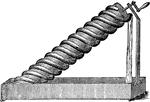
Archimedes' Water Screw
"It consists of a tube, made of lead, or strong leather, coiled round a cylinder of wood or iron, as…

Rope Machine
"The large wheel a, is supposed to stand over the well, and b, a smaller wheel, is fixed in the water.…

Centrifugal Mill
"The upright cyclinder a, is a tube which has a funnel shaped mouth for the admission of the stream…

Chain Pump
"It consists of a number of square pieces of board, or of thin iron, connected together through their…
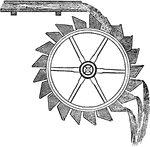
Overshot Wheel
"This wheel of all others, gives the greatest power with the least quantity of water, and is, therefore,…
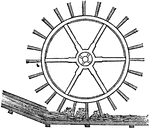
Undershot Wheel
"Thus constructed, this wheel moves equally well whether the water acts on one or the other side of…
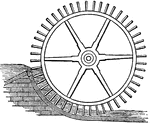
Breast Wheel
"In this water, instead of passing over, or entirely under the wheel, is delievered in the direction…

Water Ram
"Invented by Montgolfier in 1796, this only allows water to pass when the current is steady, or still,…

Common Metalic Pump
"This consists of a brass or iron barrel, A, containing at its upper part a hollow piston and valve…

Forcing Pump
"The forcing pump is represented where A is a solid piston, working air tight in its barrel. There tube,…
Atmospheric and Forcing Pump
"A curious combination of the atmospheric pump and the forcing pump, invented by Mr. Trevethick." -Comstock…

Hiero's Fountain
"After preparing the fountain, water is added into D, and later, the tube is opened to allow the air…

Refraction, air, water, glass
"Let a represent a, b water, and c a piece of glass. The ray d, striking each medium in a perpendicular…
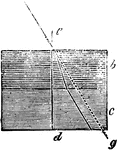
Refraction, glass and water
"Let the medium b be glass, and the medium c, water. The ray a, as it falls upon the medium b, is refracted…
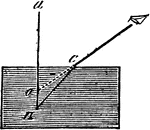
Refraction, water
"Suppose the rod a, to be set with one half of its length below the surface of the water and the other…

Deception by Mirrors
"Suppose the tumbler, a, to be filled with water, and placed beyond the principal focus of the concave…
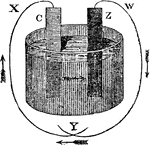
Galvanic Battery
"If we take for example, a slip of zinc, and another of copper, and place the in a cup of diluted sulphuric…
Surface Tension and Needle
"Carefully place a fine sewing needle upon the surface of the water. With care, and perhaps repitition,…
!["Get a lamp-chimney, preferably cylindrical. With a diamond or a steel glass-cutter, cut a disk of window glass a little larger than the cross-section of the lamp-chimney. Pour some fine emery powder on the disk, and rub one end of the chimney upon it, thus grinding them until they fit accurately...place [the chimney] under the water as shown. the upward pressure of the water will hold the disk in place. Pour water carefully into the tube; the disk will fall as soon as the weight of the water in the chimney plus the weight of th disk, exceeds the upward pressure of the water." -Avery 1895](https://etc.usf.edu/clipart/35900/35965/water_press_35965_mth.gif)
Water Pressure Experiment
"Get a lamp-chimney, preferably cylindrical. With a diamond or a steel glass-cutter, cut a disk of window…
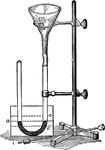
Effects of Water on Mercury in a U-tube
"After pouring mercury into the U-tube, the level of mercury is marked by a. c and e refer to the positions…
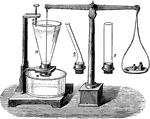
Water Pressure Independent of Vessel
"By measuring the weight required to move the end cap of any of the shown tubes filled with water, it…
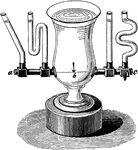
Water Level in Multiple Connected Vessels
"When any liquid is placed in one or more of several vessels communicating with each other, it will…
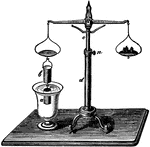
Archimedies Principle
"From one end of a scale-beam, suspend a cylindrical metal bucket, b, with a solid cylinder, a, that…
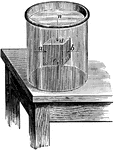
Archimedies Principle
"It is evident that, when a solid is immersed in a fluid, it will displace exactly its own volume of…
!["The most common way of determining the density of such a body [that is heavier than water] if it is unsoluble in water, is to find its weight in air (w); find its weight when immersed in water (w'); divide the weight in air by the loss of weight in water." -Avery 1895](https://etc.usf.edu/clipart/35900/35973/uscale_35973_mth.gif)
Scale Designed to Weigh Objects While Underwater
"The most common way of determining the density of such a body [that is heavier than water] if it is…

Nicholson Hydrometer
"The Nicholson hydrometer of constant volume is a hollow cylinder carrying at its lower end a basket,…

Jolly Balance
"An apparatus designed to measure the elongation or contraction of a spring when attached to two scale-pans,…

Foutain in Vacuo
"Draw out a piece of glass tubing to a jet, and push it through a perforation in a cork that snugly…
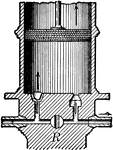
Condensing Pump
"The condensing pump is an instrument for compressing a gas into a closed vessel, as in pumping air…
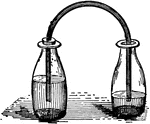
Bottle Siphon
"Partly fill two bottles with water. Connect them by a bent tube that fits closely into the mouth of…
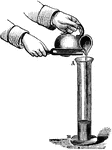
Demonstration of Resonance Using a Tuning Fork and Water Column
"Hold a vibrating tuning fork over the mouth of a cylindrical jar about 10 or 18 inches deep, and notive…
Fahrenheit and Celcius scale Thermometers
"Thermometers showing the corresponding points for water's freezing and boiling." -Avery 1895

Funnel with Inverted Mercury Thermometer
"Pass the tube of an air thermometer or of an inverted mercury thermometer through a cork in the neck…
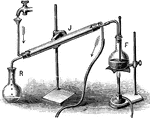
Distilation
"Partly fill with strong brine a Florence glask the cork of which carries a delivery-tube and a thermometer.…
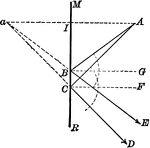
Plane Mirror
"If an object is placed before a plane mirror, a virtual image appears behind the mirror. Each point…
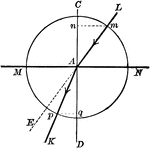
Refraction of Light Between Air and Water
"LA represents a ray of light propagated in air, falling obliquely upon the surface of the water at…
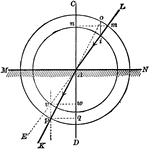
Refraction of Light Between Water and Air
"If the ray passes in the opposite direction, i.e., from water into air, the process is the reverse…
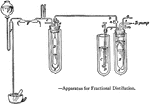
Apparatus Used for Fractional Distillation
"An apparatus setup for fractional distillation of water." —The Encyclopedia Britannica 1910

Apparatus Used to Seperate Volatile Gases
"If it be required to separate the helium which is often found in the gases given off by a thermal spring,…
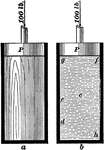
Water versus Wood Pressure
"The vessel a is fitted with a wooden bock of the same size as, and free to move in, the cylinder; the…
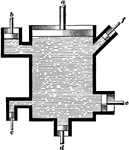
Water Pressure Demonstration
"Let the are of the piston a be 20 square inches; of b, 7 sq. in.; of c, 1 sq. in.; of d, 6 sq. in.;…
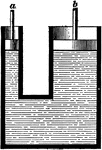
Pascal's Law and Water Pressure
"...let the area of the piston a be 1 square inch; of b, 40 square inches. According to Pascal's law,…
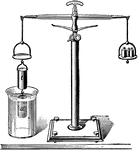
Archimedes Principle
"From on pan suspend a hollow cylinder of metal t, and below that a solid cylinder a of the same size…
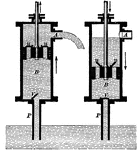
Suction Pump
"The suction pump uses suction, water pressure and one-way valves to suction water from a well or other…

Lifting Pump
"In some cases it is desired to raise water higher than it can be forced by the pressure of the atmosphere…
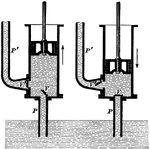
Forcing Pump
"As the piston ascends, as shown in the left-hand figure, the pressure of the atmosphere forces the…
!["A double-acting pump of the piston pattern is shown [here]. Such a pump has two sets of suction valves and delivery valves, one set for each side of the piston. With the piston moving in the direction of the arrow, the pressure of the atmosphere forces the water up the suction pipe P into the left-hand end of the pump cylinder, the left-hand suction valve opens and the left-hand delivery valve is closed...The water now flows up the delivery pipe P'." —Hallock 1905](https://etc.usf.edu/clipart/36100/36170/2act_fpump_36170_mth.gif)
Double-acting Force Pump
"A double-acting pump of the piston pattern is shown [here]. Such a pump has two sets of suction valves…

Hydraulic Water Ram
"The hydraulic ram uses alternating water pressure, air pressure, and suction to provide a steady stream…
!["Steam pumps are force pumps operated by steam acting on the piston of a steam engine directly connected to the pump, and in many cases cast with the pump. A section of a double-acting steam pump, showing the steam and water cylinders, with other details, is illustrated [here]." —Hallock 1905](https://etc.usf.edu/clipart/36100/36172/steam_pump_36172_mth.gif)
Steam Pump
"Steam pumps are force pumps operated by steam acting on the piston of a steam engine directly connected…

Method For Drying Out a Generator
"Method of drying out a generator by short-circuiting the armature leads through a water rheostat."…

Water with Salt Molecules
"...a certain amount of salt may be successfully dropped into a tumbler brim-full of water without causing…
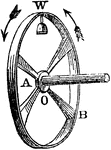
Centrifugal Force Demonstration
"AB is a wheel with a broad rim, or felly. A wine glass partly filled with water is placed on the inner…
!["A still more common form, much used in drawing water from wells and loaded buckets from mines, is shown [here]. Instead of a wheel, we have here a winch, or handle, attached to the axle." —Quackenbos 1859](https://etc.usf.edu/clipart/36300/36345/winch_36345_mth.gif)
Winch
"A still more common form, much used in drawing water from wells and loaded buckets from mines, is shown…
